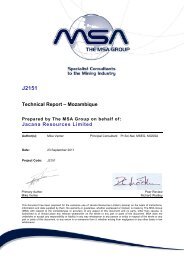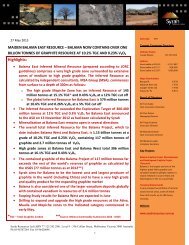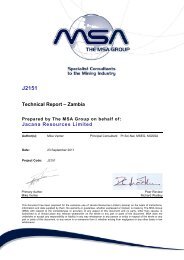Annual Report 2011 - Syrah Resources Ltd
Annual Report 2011 - Syrah Resources Ltd
Annual Report 2011 - Syrah Resources Ltd
You also want an ePaper? Increase the reach of your titles
YUMPU automatically turns print PDFs into web optimized ePapers that Google loves.
<strong>Syrah</strong> <strong>Resources</strong> Limited<br />
Notes to the financial statements<br />
30 June <strong>2011</strong><br />
Note 1. Significant accounting policies (continued)<br />
Principles of consolidation<br />
The consolidated financial statements incorporate the assets and liabilities of all subsidiaries of <strong>Syrah</strong> <strong>Resources</strong><br />
Limited ('company' or 'parent entity') as at 30 June <strong>2011</strong> and the results of all subsidiaries for the year then ended.<br />
<strong>Syrah</strong> <strong>Resources</strong> Limited and its subsidiaries together are referred to in these financial statements as the<br />
'consolidated entity'.<br />
Subsidiaries are all those entities over which the consolidated entity has the power to govern the financial and<br />
operating policies, generally accompanying a shareholding of more than one-half of the voting rights. The effects of<br />
potential exercisable voting rights are considered when assessing whether control exists. Subsidiaries are fully<br />
consolidated from the date on which control is transferred to the consolidated entity. They are de-consolidated from<br />
the date that control ceases.<br />
Intercompany transactions, balances and unrealised gains on transactions between entities in the consolidated entity<br />
are eliminated. Unrealised losses are also eliminated unless the transaction provides evidence of the impairment of<br />
the asset transferred. Accounting policies of subsidiaries have been changed where necessary to ensure consistency<br />
with the policies adopted by the consolidated entity.<br />
The acquisition of subsidiaries is accounted for using the acquisition method of accounting. Refer to the 'business<br />
combinations' accounting policy for further details. A change in ownership interest, without the loss of control, is<br />
accounted for as an equity transaction, where the difference between the consideration transferred and the book<br />
value of the share of the non-controlling interest acquired is recognised directly in equity attributable to the parent.<br />
Where the consolidated entity loses control over a subsidiary, it derecognises the assets including goodwill, liabilities<br />
and non-controlling interest in the subsidiary together with any cumulative translation differences recognised in equity.<br />
The consolidated entity recognises the fair value of the consideration received and the fair value of any investment<br />
retained together with any gain or loss in profit or loss.<br />
Operating segments<br />
Operating segments are presented using the 'management approach', where the information presented is on the<br />
same basis as the internal reports provided to the Chief Operating Decision Makers ('CODM'). The CODM is<br />
responsible for the allocation of resources to operating segments and assessing their performance.<br />
Foreign currency translation<br />
The financial report is presented in Australian dollars, which is <strong>Syrah</strong> <strong>Resources</strong> Limited's functional and presentation<br />
currency.<br />
Foreign currency transactions<br />
Foreign currency transactions are translated into Australian dollars using the exchange rates prevailing at the dates of<br />
the transactions. Foreign exchange gains and losses resulting from the settlement of such transactions and from the<br />
translation at financial year-end exchange rates of monetary assets and liabilities denominated in foreign currencies<br />
are recognised in profit or loss.<br />
Foreign operations<br />
The assets and liabilities of foreign operations are translated into Australian dollars using the exchange rates at the<br />
reporting date. The revenues and expenses of foreign operations are translated into Australian dollars using the<br />
average exchange rates, which approximates the rate at the date of the transaction, for the period. All resulting<br />
foreign exchange differences are recognised in the foreign currency reserve in equity.<br />
The foreign currency reserve is recognised in profit or loss when the foreign operation or net investment is disposed<br />
of.<br />
Revenue recognition<br />
Revenue is recognised when it is probable that the economic benefit will flow to the consolidated entity and the<br />
revenue can be reliably measured. Revenue is measured at the fair value of the consideration received or receivable.<br />
23








